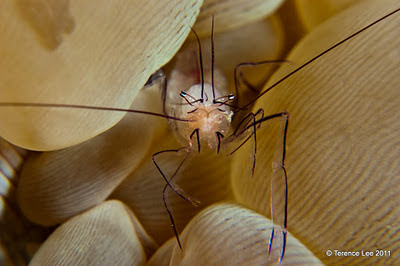I just got back from 4 days in Cabilao Island in the Visayas, the Philippines. We were in Cebu for a friend’s wedding and decided to hop over to Cabilao for some diving. I chose Cabilao because it is a secluded island with pristine reefs and is relatively undeveloped. It has a population of 4,000 people and there are only 3 small resorts on the island. We got picked up from Cebu City and a 2 hour car and 1.5 hour boat ride took us directly to
Cabilao Beach Club. All diving was with
Sea Explorers, which made all the arrangements for us.
The diving topography in Cabilao consists primarily of walls and sloping reefs. The reefs are quite healthy and there are no signs of fishing damage. However, it seems that trash on the island is not well disposed of and it is not uncommon to find discarded food wrappers underwater. The marine life is exclusively macro. It is hard to generalize about the marine life as it is quite varied, but during the course of our stay, we saw frogfish, various pipefish, various shrimp and crabs, various gobies and blennies, octopus, squid, anemonefish, and nudibranchs (only a few). The life was good but not as prolific as say, Anilao. I wish there were more sandy areas that were not covered in corals, which would make conditions more favorable for macro photography.
Unfortunately, our few days on the island were plagued with bad weather – strong winds, intermittent rain, and unpredictable conditions. We made the most of it and dove when we could. I found Cambaquiz I to be the standout dive site. It is a shallow sandy slope with coral outcroppings, which is perfect for macro photography. It is located about 200m from the Cabilao Beach Club dive shop and can accessed either by boat or from shore. It is quite sheltered from the elements, making it an ideal site in bad weather. It is also the default night dive spot for Cabilao Beach Club, which suited me well.
This was my first trip using both the Sola 600 and Dyron Double Macro M77 Lens and both proved to be good purchases.
The resort is secluded and located on a beautifully landscaped plot of land with a private beach. The dive shop and a few chalets are located on the beach, and the restaurant and a few more chalets are on a cliff 52 steps above the beach. The resort is small and personal, with something like 13 rooms. The guests are primarily European. It is very quiet and there is no entertainment other than diving. The employees are very warm and service is good. The food, however, is quite uninteresting.
Overall, I was quite happy with the resort. The macro diving is somewhere between good and great. Perhaps I have been spoiled after diving Anilao several times, but all things considered, I would go to Anilao in the future over Cabilao.








